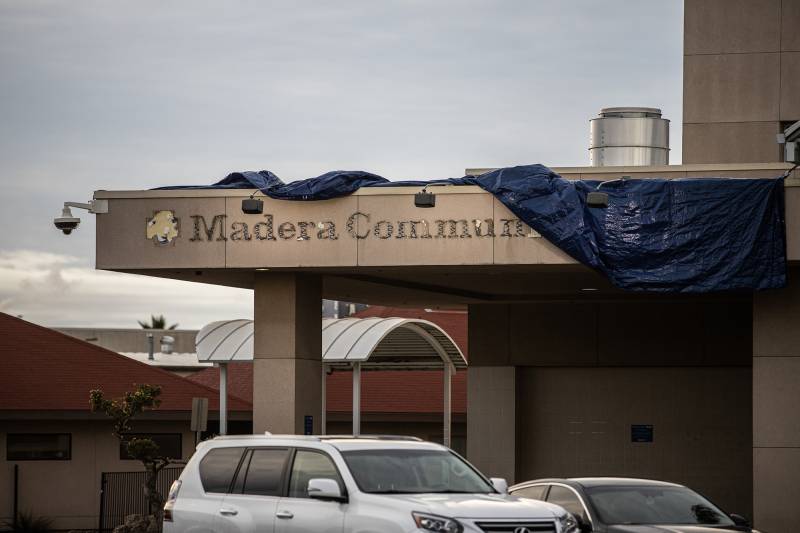Adventist Health had estimated that restarting services at Madera Community would cost at least $85 million during the first two years of reopening.
Following Madera’s closure in January, a number of community hospitals claimed that they, too, were in financial trouble. Two filed for bankruptcy and several cut service lines, including labor and delivery units. The state responded by creating the Distressed Hospital Loan program; 30 hospitals applied and 17 were selected to receive loans.
Four hospitals have received their checks, with the rest expected to go out in the upcoming weeks. Madera stands to receive the largest loan. The state recently increased the amount the hospital could qualify for by $5 million, bringing the total to $57 million.
Potential deals for Madera hospital
Madera Community Hospital could still reopen and receive its loan if another buyer or partner comes through.
Two other suitors, American Advanced Management, Inc. and Praise Healthcare, LLC, have expressed interest in taking over. For now, Madera’s hospital still has dibs on the $52 million.
“The funding is currently reserved for Madera Community Hospital,” said Andrew DiLuccia, a spokesperson for the Department of Health Care Access and Information, which selected which hospitals would get loans.
Riley Walter, an attorney representing Madera Community Hospital in bankruptcy court, said the hospital’s board is awaiting paperwork from both suitors before it can move forward. He said he expects that to happen sometime this month.
If no suitors follow through on a deal and Madera Community loses out on its loan, the state loans could be returned to the emergency fund for other hospitals to use, said Joe DeAnda, a spokesperson for the State Treasurer’s Office.
Hospitals want more transparency
To qualify for loans, hospitals had to show both financial need and a path to viability. Hospitals with low levels of cash on hand had priority, according to the Department of Health Care Access and Information. Eligible facilities had to be public, community hospitals and not owned by large health systems.
Some hospitals that did not receive loans said they wanted to see more transparency from the state’s program. At least one hospital administrator said he was unsatisfied with the response he received in the rejection email.
Steve Stark, CEO of Orchard Hospital in Butte County, said his hospital’s situation is similar to that of some of the hospitals that were granted loans.
“When we submitted our application, we were down to less than three days of cash on hand,” Stark said. “We had received an audit letter from our auditors in our last fiscal year that indicated that we wouldn’t be around in 12 months. And so by all measures that we could accumulate, we felt like we were distressed, we still are.”
Stark said one of the disqualifiers mentioned by the state was that his hospital is under a management agreement in which the Modesto-based company American Advanced Management oversees the hospital’s operations. (This is the same company that has expressed interest in taking over Madera Community Hospital.)
Other hospitals that were granted loans are also under management agreements, such as Dameron Hospital in Stockton, which has a partnership with Adventist Health.
In an emailed response, DiLuccia from the state health care information department said, “provisions within the management agreement made a difference in applicant’s eligibility.”
California sends checks
Chinese Hospital in San Francisco is one of the first four hospitals to receive its loan — close to $10.4 million. The 88-bed hospital has reported a net loss every single year since 2016, according to its financial records.
Michael Chung, the hospital’s president, said the hospital’s main challenge as a safety net provider is low reimbursements from Medi-Cal and Medicare that haven’t kept up with the growing cost of care. The hospital leans heavily on state and federal grants, as well as funds from private foundations.
“That has worked for 100-plus years, but it’s not able to sustain the hospital any longer,” Chung said.
As part of its turnaround plan, Chinese Hospital is seeking to renegotiate reimbursement rates with both private and public insurers, Chung said. Those negotiations can be a hit or miss, he said.
Low reimbursement was also a key challenge noted by Watsonville Community Hospital in Santa Cruz County, which qualified for a state loan of $8.3 million. The hospital emerged from bankruptcy only last year and operates under a nonprofit health care district.
Nancy Gere, spokesperson for Watsonville Community, said the hospital is renegotiating contracts with health insurance plans, which hadn’t been done in more than 10 years. The hospital is also considering the possibility of a general obligation bond to upgrade the facility and improve the hospital’s financial standing.
“Despite all these efforts, our expenses currently still exceed revenues, so the $8.3 million loan from the state of California is incredibly helpful,” Gere said. “The loan funds are being used to help stabilize our operations.”
